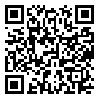Volume 10, Issue 2 (7-2010)
Iranian Journal of Medical Education 2010, 10(2): 111-123 |
Back to browse issues page
Download citation:
BibTeX | RIS | EndNote | Medlars | ProCite | Reference Manager | RefWorks
Send citation to:



BibTeX | RIS | EndNote | Medlars | ProCite | Reference Manager | RefWorks
Send citation to:
Adib Hajbagheri M. Nursing And Midwifery Students' Experiences In Efficiency Of Powerpoint In Teaching. Iranian Journal of Medical Education 2010; 10 (2) :111-123
URL: http://ijme.mui.ac.ir/article-1-1198-en.html
URL: http://ijme.mui.ac.ir/article-1-1198-en.html
, adib1344@yahoo.com
Abstract: (13762 Views)
Introduction: Divergent results are reported from studies on PowerPoint exploitation in teaching. With regard to the existing conflicts, this study was conducted to investigate nursing and midwifery students' experiences and views concerning using PowerPoint by lecturers. Methods: This qualitative study was performed using six individual interviews and two sessions of group discussion with the participation of 12 students in Kashan University of Medical Sciences. In each session, students described their experiences and views about the way teachers used PowerPoint and its impact on their learning. The interviews and discussions were recorded and transcribed, then analyzed using content analysis method. Results: Two main categories emerged from data including "the nature of PowerPoint" and "PowerPoint application culture". The second category encompassed subcategories of "correct application", "incorrect application", and "consequences of incorrect application". Participants recognized PowerPoint as an educa-tional instrument which could be used properly or improperly. Based on their viewpoints, "correct application" embraces purposeful usage of PowerPoint, integrated with other teaching methods which can lead to deep understanding of teaching content. In contrast, "incorrect application" entails rapidity in presentation, slide overuse and illustration of slides with improper structure and content, without consider-ing students' learning. This method causes tiredness and distraction as well as inattention to lesson and lack of time for deliberation in students, and reduces their interaction with teacher. Conclusion: Although proper and accurate application of PowerPoint may prove helpful in having attractive teaching and improving learning, its overuse and improper use by teachers causes the decrease in student's interaction with the teacher and consequently leads to student's aversion with this educational instrument.
Type of Study: Original research article |
Subject:
Community Based Medicine
Received: 2010/07/28 | Accepted: 2011/08/6 | Published: 2010/07/15 | ePublished: 2010/07/15
Received: 2010/07/28 | Accepted: 2011/08/6 | Published: 2010/07/15 | ePublished: 2010/07/15
Send email to the article author
| Rights and permissions | |
 |
This work is licensed under a Creative Commons Attribution-NonCommercial 4.0 International License. |




